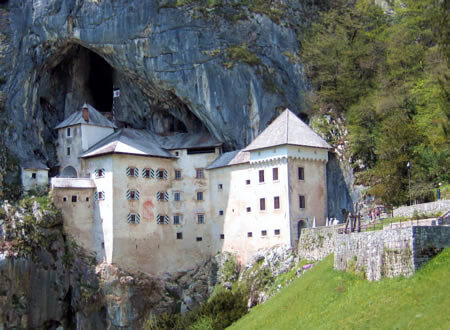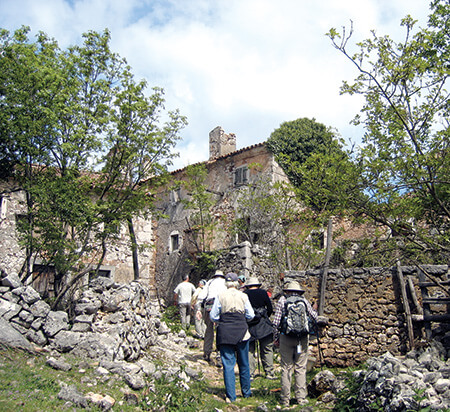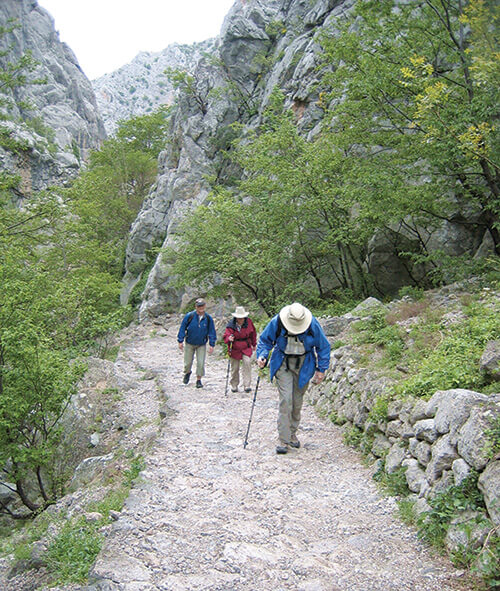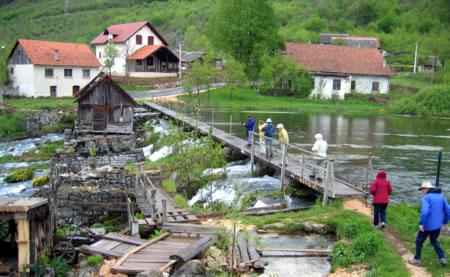Senior Travelers in Slovenia and Croatia
Explore The Cultural Layers of Regions Rich in History and Natural Beauty
Article and Photos by Alison Gardner
Senior Travel Editor
 |
| Slovenia’s dramatic Predjama Castle, built into a huge cavern by a Robinhood-like nobleman in the mid-15th century, is restored for public viewing. |
When I initially announced my trip to Slovenia and Croatia back in Spring 2005, nine out of 10 people asked about the war before anything else. Was it truly over? Were these safe countries for travel? Was there anything to see beyond sad devastation?
Having now explored the region from Slovenia’s Julian Alps in the north to Croatia’s Dubrovnik in the south, the answer to all three questions is a resounding “Yes!”
Postwar Legacy
Always the most westernized and liberal of Yugoslavia’s former republics, Slovenia and its homogeneous population of two million bear virtually no physical or psychological scars from 10 days of war and 64 casualties, the sum total of their 1991 war experience. Accepted into the European Union in 2004, Slovenia is today a secure country, a place of colorful history and spectacular natural attractions.
Neighboring Croatia, population 4.5 million, has undergone an extraordinary resurrection. With clearly-defined ethnic and religious divisions inside its borders, the turmoil deeply affected all but the northwest of the country until 1995. A gruffness and a sober distance lingers among Croats, even in their delivery of tourism.
More than a decade beyond the war trauma, tourism is clearly Croatia’s economic anchor. Restoration of its greatest historic treasures and reconstruction of roads and other infrastructure is all but complete, thanks to billions of dollars in timely donations from Europe, the U.S., and Japan. Dramatic war evidence remains in some rarely-visited interior communities where proudly-maintained Croat homes, gardens, and farms stand beside looted and bombed Serb properties. Along the roadside, occasional skull-and-crossbones signs warn about land mines in the untended fields nearby. In coastal cities like Zadar and Dubrovnik, where fighting was heaviest, some stone public buildings and apartments still bear bullet scars.
 |
| The remains of a fine historic village on Cres Island, Croatia deserted in 1980 for lack of water, not because of war. |
Bewitched by Nature
Well-traveled Europhiles are aware of the rich, well-preserved crossroads history of the Balkans region. Far less recognized are the opportunities for active nature exploration in remarkably accessible environments.
Together with 12 American and Canadian friends, ages 55 to 75 years, I spent half my trip in light hiking boots with my adjustable walking stick in hand. We tramped for hours at a time through national parks (a number of them UNESCO World Heritage Sites) and around shorelines of royal-blue lakes and tiny islands decorated with medieval monasteries and churches. One day we trod color-coded trails through fragrant forests on Croatia’s Island of Cres and shared a leisurely picnic in a grassy clearing where sheep have grazed for a thousand years.
 |
| Well-designed trails in Croatia’s Paklenica Gorges National Park provide challenging elevation changes and spectacular mountain scenery |
Lake Bled and Lake Bohinj, high in Slovenia’s northern Julian Alps, and the country’s two unique national cave parks in the south set the expectation bar very high in the first five days of my trip. Wandering open-mouthed through the sculpted beauty of 12-mile-long Potstojna Cave, with its smooth pathways, sturdy bridges, and perfectly back-lit limestone formations, I doubted I would ever see a more dramatic cave setting. But I was wrong. Next day we trekked far more gingerly through the even larger Skocjan Cave system, more brooding and rugged, with major elevation changes and bridge crossings, to the echoing sounds of a raging underground river dizzyingly far below. For several hours, I felt like I had stumbled into a Lord of the Rings movie set.
Croatia’s natural smorgasbord proved equally dazzling. Rick Steves admirably described Plitvice National Park for Transitions Abroad: “Imagine Niagara Falls diced and sprinkled over a heavily forested Grand Canyon.” Composed of 16 interlinked lakes stepping down the face of a gently-angled mountain, waterfalls surprise the visitor from every direction. The entire park is laced with raised boardwalks offering the best possible views safe from the cascades of water. Krka National Park offered an equally dramatic waterfall and forest landscape.
Our guide warned us that Paklenica Gorges National Park was the most challenging hike of our trip because of the elevation change. Several of our group passed on this one, though the well-tended stone trails and steps leading into the narrow gorge were more manageable than I had anticipated. As always, coming down was more perilous. Vertical cliffs dropped 1,500 feet in places.
 |
| Now abandoned beside an unmarked single-lane road, 19th C. watermills complete with remnants of flour-grinding equipment straddle a picturesque river in Croatia's countryside. |
From my overview, it is impossible to name my favorite park or nature experience. Each one added a memorable surprise to my itinerary, and a compelling reason to visit these up-and-coming destinations.
For More Info
Best Seasons: The weather is most reliable from May through September. Shoulder seasons mean less European tourists, less intense heat than July and August, and better hotel prices.
In-Country Travel: A reliable public bus network services many areas of travel interest, and scheduled ferries connect islands to the mainland and Adriatic coastal cities to each other. Moderately-priced train travel is also a good option. Once away from tourist areas, not a lot of English is spoken. Restaurant cuisine and 3- to 4-star accommodations are not strong features of either country. I participated in a 2-week small-group tour newly developed by ElderTreks, which specializes in active educational adventures exclusively for 50-plus travelers in over 50 countries.
Recommended online guides with print publication options: Lonely Planet: Croatia, the Rough Guide to Slovenia, and the Rough Guide to Croatia.
|
|
